Order Anura Higher classification Rana | Phylum Chordata Family Ranidae Scientific name Rana muscosa Rank Species | |
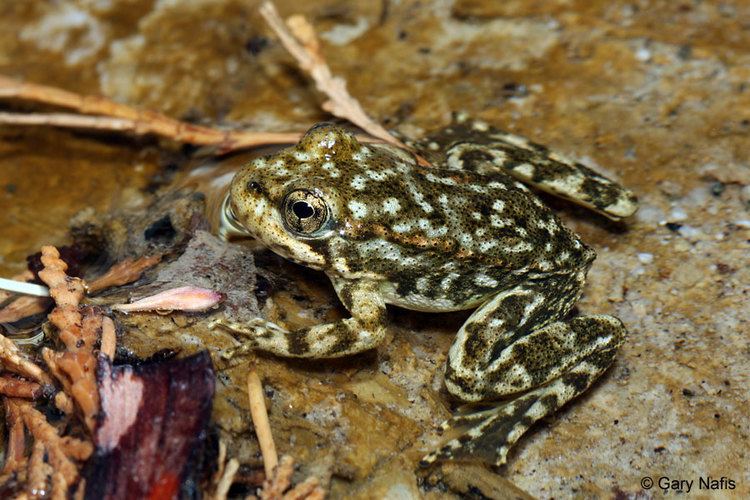 | ||
Similar Frog, Sierra Nevada yellow‑le, Foothill yellow‑legged frog, Amphibians, Rana | ||
Mountain yellow legged frog
The mountain yellow-legged frog or southern mountain yellow-legged frog (Rana muscosa) is a species of true frog endemic to California in the United States. It occurs in the San Jacinto Mountains, San Bernardino Mountains, and San Gabriel Mountains in Southern California and the Southern Sierra Nevada. It is a federally listed endangered species.
Contents
- Mountain yellow legged frog
- Description
- Habitat
- Biology
- Conservation status
- Decline
- Introduced fish species
- Pesticides
- Chytridiomycosis
- Conservation
- References
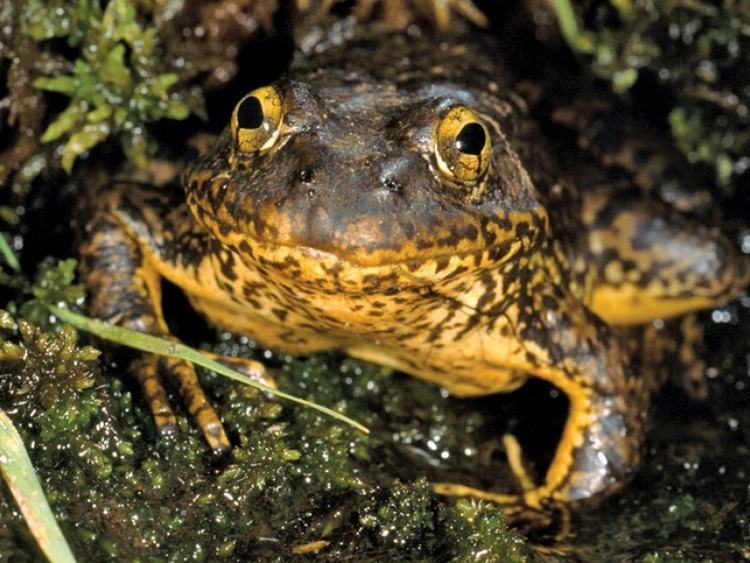
Populations of Rana muscosa in the northern Sierra Nevada have been redescribed as a new species, Rana sierrae, the Sierra Nevada yellow-legged frog. This has been proposed as an endangered species as of 2013. The mountains separating the headwaters of the South Fork and Middle Fork of the Kings River mark the boundary between the ranges of the two species.
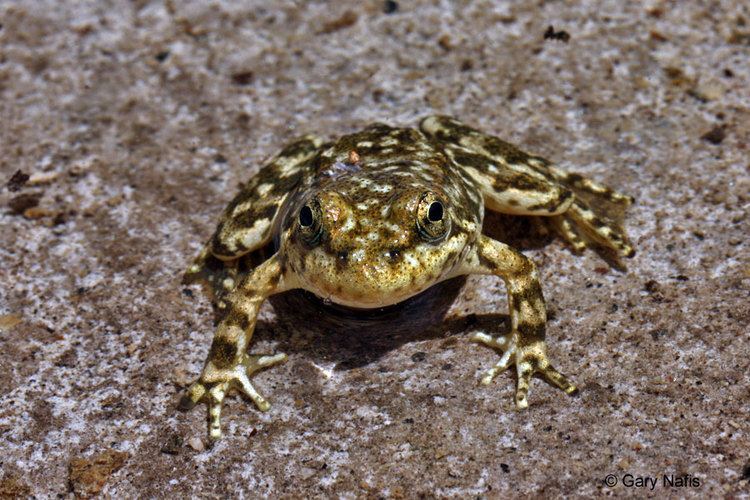
Description
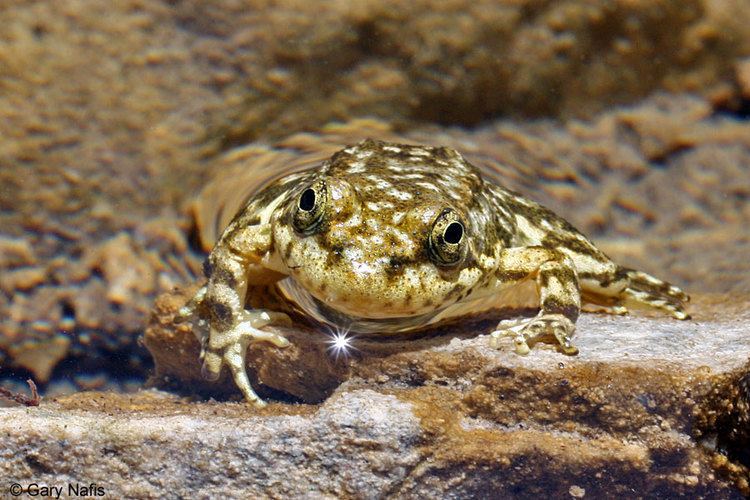
Rana muscosa is 4 to 8.9 centimeters long. Its color and patterning are variable. It is yellowish, brownish, or olive with black and brown markings. Its species name muscosa is from the Latin meaning "mossy" or "full of moss", inspired by its coloration. It may have light orange or yellow thighs. When handled, the frog emits a defensive odor reminiscent of garlic.
Habitat

The frog occurs in mountain creeks, lakes and lakeshores, streams, and pools, preferring sunny areas. It rarely strays far from water, and can remain underwater for a very long time, likely through cutaneous gas exchange. The tadpoles require a permanent water habitat for at least two years while they develop. The frog has been noted at elevations of between about 1,214 and 7,546 feet (370 and 2,300 meters) in Southern California.
Biology
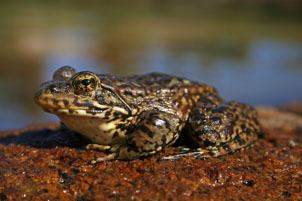
The frog emerges from its wintering site soon after snowmelt. Its breeding season begins once the highest meltwater flow is over, around March through May in the southern part of its range, and up to July in higher mountains to the north. Fertilization is external, and the egg cluster is secured to vegetation in a current, or in still waters sometimes left floating free. The juvenile may be a tadpole for 3 to 4 years before undergoing metamorphosis.
The frog lacks a vocal sac. Its call is raspy, rising at the end. During the day, it calls underwater.
This species feeds on insects such as beetles, ants, bees, wasps, flies, and dragonflies. It is also known to eat tadpoles.
Conservation status
The frog is an endangered species under the US Endangered Species Act. The International Union for Conservation of Nature has also listed it as endangered. Its NatureServe conservation status is Imperiled.
Decline
Once a common species, Rana muscosa was absent from much of its native range by the 1970s. Over the course of the last hundred years, 90% of its populations have been eliminated. The frog was known from 166 locations in the Southern California mountains, and as of 2007, only seven or eight remained. The 2009 discovery of R. muscosa at two locations in the San Bernardino National Forest was newsworthy. The frog is represented in the Sierra Nevada by three or four populations. Its decline is attributed to many factors, including introduced species of fish such as trout, livestock grazing, chytrid fungus, and probably pesticides, drought, and ultraviolet radiation.
Introduced fish species
Trout were introduced to lakes and streams throughout the Sierra Nevada in the late 1800s to increase recreational fishing in the area. The fish feed on tadpoles, a main prey item. The introduced trout have changed the distribution of several native species in the local ecosystems. After the removal of fish from several lakes, the frog reappeared and its populations increased. It then began to disperse to other suitable habitats nearby.
Pesticides
The decline of the frog from its historic range has been associated with pesticide drift from agricultural areas. Frogs that have been reintroduced to water bodies cleared of fish have failed to survive, and analysis has isolated pesticides in their tissues. Pesticides are considered by some authorities to be a greater threat to the frog than the trout. The relative roles that pesticides and introduced fish play in frog declines are still debated, and the loss of R. muscosa in its former range has probably been influenced by multiple factors.
Chytridiomycosis
This species is one of many amphibians affected by the fungal disease chytridiomycosis. Ample research has explored the biology of the fungus and how to prevent related amphibian declines. The fungus attacks keratinized areas of a frog's body. Tadpoles are not severely affected because only their jaw sheaths and tooth rows are heavily keratinized. Infection in a tadpole can be identified by changes in the pigmentation of these parts. Adults have keratin-rich skin and suffer worse infections.
In studies, well adult frogs exposed to infected frogs for at least two weeks developed the disease. Transmission takes longer in tadpoles, generally over seven weeks. Frogs may be predisposed to infection if their immune systems are weakened by other factors, such as pesticide. Studies indicate that R. muscosa is naturally more susceptible to the chytrid fungus than many other frogs to begin with.
Conservation
The first successful captive breeding of the frog occurred in 2009 when three tadpoles were reared at the San Diego Zoo. Conservation workers at the zoo plan to release any more surviving captive-bred frogs in the San Jacinto Mountains, part of their native range.
In 2015 frogs and tadpoles of the species were reintroduced to Fuller Mill Creek in the San Bernardino Mountains and San Bernardino National Forest. They were bred and raised the Arnold and Mabel Beckman Center for Conservation Research in Escondido, one of the organizations that have partnered with the San Diego Zoo Institute for Conservation Research (ICR) to save the species from extinction. The Los Angeles Zoo is also a coalition partner and currently is holding two groups of wild collected tadpoles from two localities in the San Gabriel Mountains, to be they are old enough and conditions are supportive.
